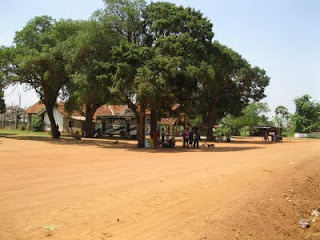The last time I visited Jaffna was in late 2004. Thats not the absolute truth, because I did go to Jaffna in December 2010. That was with two classmates and their families and I was in a perpetual haze and trying to be (I dont think I needed to try hard) to be a nuisance. Into the bargain the camera had stopped working. It started working again when my brain was a little more coherent and I hit it, as in the camera against the wall. This works for my brain as well at times.
The 2004 trip was quite a journey. Many a story and one of these days I will get around to writing about it. The LTTE customs checkpoint, the LTTE exhibition at Kilinochi. Photos from that trip and blog post on that trip here.
Anyway as usual before going to any place where I dont know the language, brushed up with some useful phrases which work wonders like;
Amma/Aiya Onglaku Mitchum Nanri: Madame/Sir thank you very much.Back to the bus trip. Left Colombo 6:45 am semi luxury (no different from normal buses, just higher price). Cost LKR 400 per person. I dont like air con buses for long distances. It seems they either turn off the air con off or if it is cold enough to my liking, the other passengers want the cold turned down. Normal buses, you get a corner seat making sure the window is under your control, i.e. it closes/opens at your seat. If your neighbor complains its too cold, the drizzle is coming in, explain that you vomit all over the place if you dont have a window open. One time while traveling up country early with a frigid air blowing on my face, explained that I do my morning meditation and the cold air helps me focus my mind on the Dhamma. Nothing like religion to exploit your needs or foibles. On the other hand you could have the odd swig or too from a bottle of booze. You will not be asked any questions, in fact many will keep a healthy distance from you. More likely you will be the loquacious question asker.
Theivadu, Thanni konjam Tharungo: Please can I get a little water (replace Thanni=water with whatever)
Ungalaku Nalla Naal: You have a good day. I would replace Naal=day with Rathri=Night, in the evening. My vocabulary did not extend to the word for evening
A few other things like if it is a North South oriented journey, sit on the west side before noon and on east after noon to avoid direct sun. Too bad if what you want see is on side of the sun, like a west coast ride in the afternoon and you want to see the ocean.
Arrived in Mannar at around 3:30 p.m. Stayed at the Manjula Inn (2nd Cross St, Mannar; Tel 023 2222037, Mobile 077-6038525), walking distance from the bus stand. Its a house from the 50's a section of which has been converted to an Inn. I stayed in one of the upstairs rooms, attached toilet. Place is clean, toilet tiled and clean but the drain was of cement and didnt look too attractive. That said this place is not let out on a short term basis, i.e. you dont have to be wondering who was doing what in the bed a few hours before you checked into the room. The owner Sam Ratnaraj, a retired gent was displaced from Negombo during the 83 riots and moved to Mannar his wifes hometown. Strong and vocal opinions of what has happened and should happen but no wish to settle elsewhere. Sam is also otherwise busy at the moment funding his two grand kids thru University in the UK.
The evening I arrived did the standard Baobab Tree and the Mannar Fort and the Donkeys. Late evening did a pleasant 3 km walk to the Mannar Station (destroyed by the LTTE). This was kind of a forced walk. The three wheel guy asked for LKR 300 and probably should have been around LKR 100 (approx 30 to 35/km), so walked, a good decision in retrospect as it was a nice pleasant area. Hopped a three wheel back for LKR 150.
The Little Donkey in the Mannar Fort

The Donkey Family framed from a window.  Inside the Fort: I think this was the Chapel
Inside the Fort: I think this was the Chapel
 The Mannar Bridge. The metal bridge was constructed by Kobbekaduwa (I think) after the old Mannar bridge was blasted by the LTTE. The more permanent concrete bridge is of recent vintage.
The Mannar Bridge. The metal bridge was constructed by Kobbekaduwa (I think) after the old Mannar bridge was blasted by the LTTE. The more permanent concrete bridge is of recent vintage.

The Baobab Tree
 Inside the Fort: I think this was the Chapel
Inside the Fort: I think this was the Chapel The Mannar Bridge. The metal bridge was constructed by Kobbekaduwa (I think) after the old Mannar bridge was blasted by the LTTE. The more permanent concrete bridge is of recent vintage.
The Mannar Bridge. The metal bridge was constructed by Kobbekaduwa (I think) after the old Mannar bridge was blasted by the LTTE. The more permanent concrete bridge is of recent vintage.
The Baobab Tree

More photos and other locations in the vicinity by another author http://trips.lakdasun.org/trip-to-mannar-and-talei-mannar.htm
Next: Part 2: Talaimannar and Madhu






















